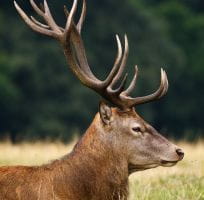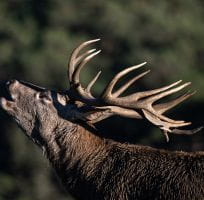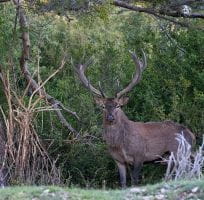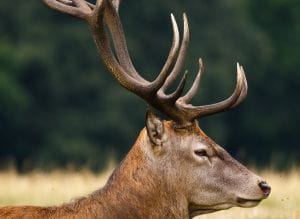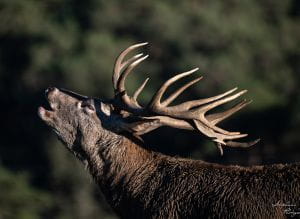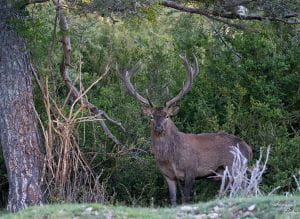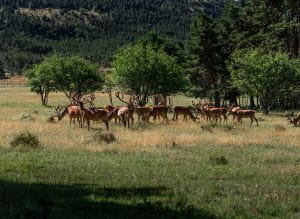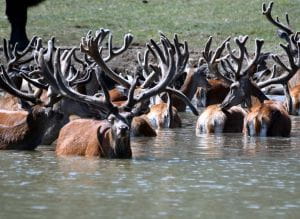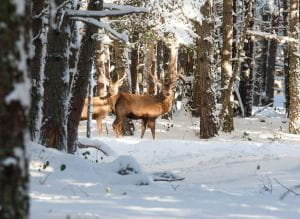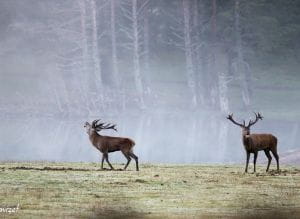The red deer (Cervus Elaphus) horns or antlers?
With the exception of reindeer, antlers are the preserve of male cervids. It is a spongy bone that falls and grows back each year, from a small bump on the skull: the pivot.
The horn is worn by both sexes, as in bison, chamois, mouflon and ibex, for example. Made up of a central bony part, an extension of the frontal bone, and a horny sheath, it remains in place throughout the animal’s life. Its growth is continuous but not constant. A difficult period, for example, leads to a slowdown in growth.
Of the forty or so currently known species of deer, all except the Chinese water deer or hydropote (Hydropotes inermis) develop antlers. Moreover, antlers are only borne by males, with the exception of the reindeer (Rangifer tarandus), a species in which the female also has them.
Antlers are spongy bony organs found on the heads of cervids. The vast majority are found only in males and are all deciduous, meaning that they fall off each year (at the end of winter in temperate environments). Among mammals, antlers represent the only organ capable of regenerating entirely. In Cervus elaphus, antlers develop from the first 9 to 12 months.
During its first two years, the young male is called a daguet (in reference to its dagger-like antlers, the hunting knife used to finish off the animal when hunting).
The antlers fall off every year towards the end of winter and grow back in early spring from a small bump on the skull called the pivot. The antlers of this species are one of the fastest growing bones in the animal kingdom, growing at a rate of 1 to 2 cm per day.
At the start of their growth, which begins in spring, the antlers are covered in integumentary tissue (velvet) that protects, vascularises and innervates these organs. This is known as velvety wood.
This tissue dries out and falls off when bone growth is complete, towards the end of summer: this is the spawning period. During spawning, the animal rubs its antlers against solid objects in its environment, usually tree trunks, to accelerate the fall of the velvet.
The antlers will remain bare throughout the rut (September/October in Europe) but they continue to be vascularised, not by large external arteries (dried out by spawning) but by fine internal capillaries running through the hollow tubes of the spongy bone. At the end of winter, the wood detaches from the skull and its location remains marked by a pedicle (the pivot) until the new shoots grow.
Antlers have different functions:
– defence against predators
– as a “beauty” feature for females (known as a “secondary sexual apparatus”),
– as a weapon of attack or defence against other males for territory, resources or access to females,
– sound amplification (resonance) when bellowing (for moose only),
Antler growth depends on the age of the individual, but not only that. It is above all a question of the resources found in the environment (proteins and minerals in spring) and the activity of the individual. For example, the size of a cervid’s antlers and the number of horns will never be the same from one year to the next, and the two antlers of the same individual are not always symmetrical.
Stags shed their antlers every year, at the end of winter or the very beginning of spring, and put on a new set of antlers every summer.
During the regrowth period, which lasts until early summer, they tend to isolate themselves (males aged 5 and over) or live in small groups (males aged 2 to 5). It also moults into its shiny reddish-brown summer coat.
A little history
The first cervids are thought to have appeared during the Oligocene (33 to 23 million years ago) on the plains of southern Asia. They are thought to have colonised Eurasia and North America from the end of the Oligocene and only colonised South America a few million years later, around 10 million years ago. Cervids on other continents only appeared very recently.
Deer populations during the last ice ages (11,000 years ago) included several species in Europe, including the famous Megaceros (Megaloceros giganteus), or bog deer, whose antlers can reach 3.50 m from one end to the other. A symbol of royalty, nobility, wisdom and elegance in the Middle Ages, the red deer has inhabited European forests for several thousand years.
In France, the disappearance of the red deer in our region certainly dates back to the 17th century, when hunting quotas had not yet been introduced. It was gradually reintroduced to the forests between 1950 and 1960 (in 1954 for the Cheiron population), on the initiative of the Conseil Supérieur de la Chasse, the Administration des Eaux et Forêts and the Hunting Federation. Studied for a long time, this species has seen its populations increase rapidly, and has adapted very well to the ecological conditions of the Mediterranean mid-mountains. It mainly occupies two levels of vegetation, the hilly (700 to 1,000 metres altitude) and the mountainous (1,000 to 1,500 metres).
For the record, the etymology of its name, Cervus elaphus, is a pleonasm since “Cervus” is the Latin genus name for deer and “elaphus” means “stag” in Greek.
The translation of its Latin name is therefore “cerf cerf”!
Condemned by Man …… to a forest life
The red deer is a large species, with adult males reaching up to 1m 45 and 250kg, while females weigh between 100 and 130kg with a height at the withers of between 90 and 120cm.
This large mammal is probably the animal with the best-known sexual dimorphism. In addition to their differences in size and weight, bucks have antlers, while does do not.
Its diet is that of a ruminant herbivore. It consumes around 15 kg of vegetation a day, mainly herbaceous plants, with a clear preference for young shoots. But that’s not all. In autumn and winter, it varies its diet to maximise its chances of finding food, consuming lichen, bark, buds, twigs and even dead leaves!
It originally lived in the large clearings of the primary forest. The development of agriculture gradually drove it out. Today, the red deer spends most of its time in forested areas, only moving into clearings and meadows at nightfall.
An intense social lifea big kid
To avoid human or animal predation, deer have adopted gregarious behaviour and tend to feed in open habitats. Several eyes scan their surroundings for the slightest danger. Sight, hearing and smell are well-developed senses in deer, enabling them to detect predators. In Europe, red deer are an important source of food for many carnivores, especially as several scientific studies (notably those by INRA) have shown that increasing deer populations tend to reduce those of roe deer.
The red deer lives in herds for most of the year. The composition of these herds varies according to the season: herds of males in spring and winter, herds of females and young in spring, mixed herds in autumn.
The red deer is a social animal that loves to play at any age: galloping, jumping, boxing and, above all, rolling in the mud. Males, females and young alike take great pleasure in covering themselves in mud, from head to toe.
The French Office for Biodiversity (OFB) estimates that the red deer is one of the world’s most endangered species.
According to the Office Française pour la Biodiversité (OFB), deer now occupy more than half of French forests, compared with less than 20% thirty years ago. In the wild, the red deer population will number around 150,000 individuals in 2023, compared with 65,000 in 1994.
In the Réserve des Monts d’Azur, the red deer has rediscovered conditions of tranquillity that enable it to be observed in the middle of the day, free from its many social activities.
mating seasona hectic sex life
At the end of August, red deer begin their mating season. In the Réserve des Monts d’Azur, the stag brays at night but also for much of the day. It emits jerky, hoarse and powerful hiccups not unlike the roars of rutting lions, showing its determination to its adversaries.
There are different hiccups depending on the messages to be conveyed:
– presence bellow: a short bellow to signal your presence,
– triumphant bellow: a powerful cry for the winner of the fight,
– longing bellow: long and isolated, to attract hinds,
– defiant bellow: provocative call to a competitor,
– chase bellow: when the stag is chasing a doe or another buck.
During this bellowing period, the stag wants to be heard. It is perfectly aware that its song will attract both females and males in competition, as well as predators! This initiative is therefore intended to show the female that it has mastered its territory (previously marked by rubbing against trees or the presence of its stumps), and that it feels capable of confronting a predator.
Contrary to popular belief, males do not force females to stay. His bark is intended to attract them to his singing area to show them where he is and what he looks like. Females entering this territory will then be offered parries such as running, ejaculation and, if an adversary enters the territory, fighting.
These fights are rarely unequal, with the youngest stags rarely taking on the more experienced males.
During the rut, the stag stops feeding to devote itself to preserving the unity of its herd, chasing off any rivals with its antlers. This is a difficult time for him, especially as the hinds do not remain insensitive to the charms of the neighbour and do not hesitate to roam from one to another! The bellowing of the red stag can last until November, and deaths among the bucks are frequent, especially if the winter that follows is harsh.
The fawns are born in spring after an eight-month gestation period. The mother gives birth in a quiet, covered area after leaving the herd. The calf weighs between 6 and 8 kg. It will remain carefully hidden in the vegetation for 2 to 3 weeks, only appearing to suckle its mother.
The red stag sports a new set of antlers every spring. It sheds its antlers every year, at the end of winter or at the very beginning of spring. During the regrowth period, which lasts until early summer, they tend to isolate themselves (males aged 5 and over) or live in small groups (males aged 2 to 5). It also moults into its shiny reddish-brown summer coat.
